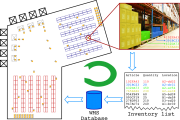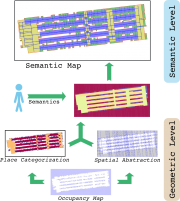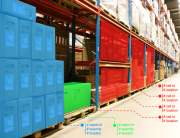AIMS
Automatic Inventory and Mapping of Stock
| AIMS | |
| Project start: | |
|---|---|
| 1 January 2012 | |
| Project end: | |
| 1 January 2016 | |
| More info (PDF): | |
| Contact: | |
| Björn Åstrand | |
| Application Area: | |
| Intelligent Vehicles | |
Involved internal personnel
| |
| |
Involved external personnel
| |
Involved partners
| |
Abstract
The state of the art in autonomous robotics has advanced sufficiently that open implementations of many core technologies are now readily available. Consequently, there is growing research on the design and development of innovative solutions that leverage insights from several specialist domains. The AIMS project lies in this category. Its goal is to develop a system that seamlessly combines inventory management with autonomous forklift trucks in intelligent warehouses. Information compatible with human operators, management systems, as well as mobile robots is of particular importance here. A rich and "live" map combining metric and semantic information is a crucial ingredient for effective management of logistics and inventory, especially for autonomous fleets working in the same space as humans and human-operated devices.
Introduction
An important skill for future robots and automated guided vehicles (AGVs) is the ability to recognize and describe objects that the robot shall handle and the environment in which the robot operates. This is an important step towards making robots more intelligent (situation awareness). The ability to structure and sort information provided by sensors increases the system’s flexibility and ability to adapt to new settings (which in the end means lower costs). To do this with as few input parameters as possible is also a challenge. The goal with this project is to develop a system for automatic inventory and mapping of goods in a warehouse setting and associate these with articles in the warehouse management system. Objects are augmented into a semantic map and can be both goods and objects belonging to the warehouse infrastructure, e.g. pallet rack and pallets. The semantic map can be further expanded with objects belonging to the building (doors, columns, etc.) and mobile objects that appear in the path of the robot (pedestrians, forklift trucks, etc.). The project thus also includes building a concept map of the area of operation
This project is a collaboration between the CAISR, Kollmorgen, Optronic and Toyota Material Handling Europe.
Motivations
An important skill for future robots and automated guided vehicles (AGV:s) is the ability to recognize and describe objects that the robot shall handle and the environment in which the robot operates. The ability to structure and sort information provided by sensors increases the system's flexibility and ability to adapt to new settings. The purpose of AIMS is to make autonomous systems and AGV:s operating in a warehouse setting more intelligent, by extending their functionality with a system for automatic inventory and mapping of goods. Achievement of this purpose requires:
- situation awareness: through different types of sensors, data fusion and employment of novel methods for interpretations of the information.
- maintaining practicability by means of flexibility and adaptability for handling variety of environments and sensor's data.
Objectives
acquiring the skills of situation awareness, flexibility and adaptability, demands accomplishment in different disciplinary areas:
- Mapping and semantic annotation, both as a foundation of the semantic map for addressing articles and trucks in the environment, and to provide an automatic surveying and layout design for initial installation.
- Inventory list maintenance; a dynamic map maintenance approach in order to keep track of the inventory, linked with the warehouse management system.
- 3D Perception; serving the objectives of obstacle avoidance and articles' quantity estimation for inventory list.
| ||


